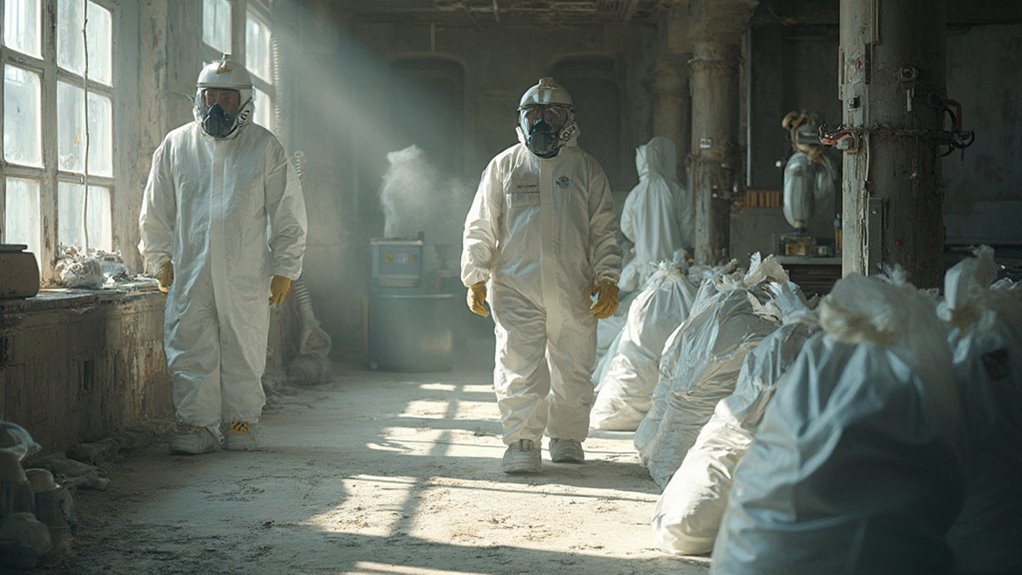Asbestos abatement requires thorough preparation and adherence to regulations to guarantee safety and compliance. Start with certified inspections to identify asbestos, notify relevant agencies, and inform occupants. Utilize safe work practices, like wet methods, and equip workers with proper PPE. Have emergency protocols ready in case of fiber release, guaranteeing immediate containment and clean-up. Manage HVAC systems properly to prevent contamination during the process. Finally, confirm regulatory compliance and conduct thorough final inspections. By guaranteeing you follow this checklist, you can navigate the complexities of asbestos abatement effectively and safely. More insights await you in the details.
Pre-Abatement Preparation

Before diving into asbestos abatement, extensive pre-abatement preparation is crucial to guarantee safety and compliance. Start by ensuring accurate asbestos identification through thorough inspections. Hire certified inspectors to identify all asbestos-containing materials (ACMs) within the work area, documenting their locations and quantities. Assess all affected areas, including those above, below, and adjacent to the planned renovations or demolition. Professional testing is essential for confirming the presence of asbestos and ensuring proper management of risks.
Next, initiate regulatory notifications. Notify relevant agencies, such as the Department of Environmental Protection (DEP) and Environmental Protection Agency (EPA), at least 10 days prior to commencing abatement work. Inform all occupants on affected and adjacent floors about the upcoming operations, and post clear notices at all access points, including doors and stairways.
Additionally, prepare the site by clearing personal belongings and furniture from the work area to minimize contamination risks. Pre-cleaning is essential to ensure that surfaces are free of asbestos fibers before beginning the abatement process. Seal off work areas using plastic sheeting and negative air pressure units to contain asbestos fibers. Turn off HVAC systems to prevent fiber circulation, and establish decontamination areas for personnel and equipment. By following these steps, you'll create a safer environment for the asbestos abatement process.
Safe Work Practices
When working with asbestos, always use wet methods to minimize airborne fibers and maintain a controlled environment. Confirm all personnel wear appropriate PPE, including NIOSH-approved respirators and protective clothing, to safeguard against exposure. Furthermore, implement effective containment measures to prevent unauthorized access and limit the spread of asbestos materials. Additionally, it is vital to conduct comprehensive inspections to identify and assess any asbestos-containing materials before beginning the abatement process.
Wet Methods Usage
Utilizing wet methods for asbestos removal is vital to minimizing fibre release and ensuring a safer work environment. By employing effective wetting techniques, you can thoroughly saturate asbestos-containing materials, which greatly reduces the likelihood of airborne fibers. Utilize low-pressure sprayers to control water application and consider adding wetting agents to improve absorption.
Before starting, isolate the work area with barriers and signage to restrict access and implement containment measures to avoid water damage to surrounding areas. Use wet-wiped or HEPA-filtered vacuumed drop sheets and barriers to improve fiber containment during the removal process. It's critical to clean the work area frequently throughout the removal, ensuring the site remains free from debris.
Handle asbestos waste while it's still wet, sealing containers securely to prevent any fiber release. Properly label all waste for safe disposal, and double-bag materials when possible. Remember, addressing accessibility challenges and utilizing specialized equipment are key to maintaining effectiveness during the abatement process. By following these guidelines, you'll not only comply with safety standards but likewise protect yourself and others from asbestos exposure.
PPE Requirements
Following effective wet methods, selecting appropriate personal protective equipment (PPE) is fundamental for guaranteeing safety during asbestos abatement. You must use NIOSH-approved respirators, such as N100 or P100, to safeguard against harmful asbestos fibers. Your coveralls should be made of synthetic materials, designed to prevent fiber infiltration, and should lack external pockets or Velcro. Disposable gloves offer a critical barrier against skin contact, while eye protection is essential for shielding against irritants.
Regarding PPE types, verify your gear fits properly and remains comfortable for extended wear. Always opt for disposable items to reduce cross-contamination. During removal tasks, full-body PPE is mandatory, including respirators, coveralls, gloves, and eye protection.
PPE maintenance is crucial; regularly inspect your equipment for damage and replace it as necessary. Follow strict protocols for proper disposal, including double bagging and sealing all used PPE. After your work, shower and clean thoroughly to remove any residual asbestos fibers that may have adhered to your skin or hair. By adhering to these guidelines, you can markedly reduce your risk of asbestos exposure during abatement activities.
Containment Measures
Effective containment measures are crucial in minimizing asbestos fiber release during abatement activities. Implementing appropriate containment strategies helps create a safe work environment. Start by isolating and sealing the work area; this includes disabling the HVAC system and sealing air ducts. Use thick plastic sheets to secure areas not undergoing treatment, guaranteeing an air pressure differential through proper filtration.
Different enclosure types serve specific purposes. While full containment is ideal for extensive abatement projects, mini-enclosures may suffice for short-duration tasks, limiting dust spread effectively. Always verify that all perimeter edges are sealed with duct tape to reinforce containment.
Employ wet methods to suppress dust during the removal process. Opt for non-powered hand tools, which generate minimal dust, and handle materials carefully, lowering them onto polythene sheeting. Establish contingency measures for potential fiber release incidents to address hazards promptly.
Lastly, utilize decontamination units for waste disposal and worker exit, assuring a thorough clean-up of the work area. By following these containment measures, you greatly reduce the risk of asbestos exposure and maintain compliance with safety regulations.
Emergency Procedures

In an emergency involving fiber release, you need to follow established protocols to guarantee safety. Immediately initiate cleanup actions to contain the spread and manage the HVAC systems to prevent further contamination. Your prompt response is vital in minimizing exposure and adhering to regulatory requirements.
Fiber Release Protocols
What should you do in the event of a fiber release? First, stop all work immediately in the area with damaged asbestos materials. Evacuate everyone from the vicinity, guaranteeing that no one remains in the affected space. If it's safe, close all windows and doors leading to other areas to minimize airflow. Never attempt to re-enter the release area or clean up the impacted materials yourself.
Next, isolate the area by closing doors and erecting temporary barriers to restrict access. Post clear signage indicating "potential asbestos contamination" to deter non-critical personnel from entering. Inform building occupants and adjacent areas about the fiber release to keep them safe.
Modify HVAC systems if needed to prevent the spread of fibers; if that's not possible, seal off the affected area. Collect detailed information about the incident, including the location and amount of asbestos-containing material disturbed. Coordinate with environmental health and safety personnel for a proper emergency response and arrange for licensed contractors to conduct the cleanup and decontamination. Remember, thorough monitoring of all activities is crucial to guarantee safety throughout the process.
Immediate Cleanup Actions
When faced with an asbestos fiber release, it's vital to spring into action with immediate cleanup procedures to guarantee safety. Asbestos exposure can have serious health ramifications, so your emergency response should prioritize containment and decontamination.
- Restrict Access: Immediately limit access to the contaminated area. Post warning signs and lock off the zone to prevent unauthorized entry.
- Stop Work Activities: Cease all work in the affected zone to minimize disturbance and further fiber release.
- Decontaminate Personnel: Confirm that anyone who entered the area decontaminates using showers and changes of clothes, employing damp rags for wiping down any contaminated gear.
- Dispose of Materials: Collect any asbestos debris in leak-tight, sealed containers and use HEPA-filtered vacuums for thorough area cleanup.
HVAC System Management
Effective HVAC system management during an asbestos emergency is crucial for minimizing risk and guaranteeing safety. Begin by conducting background air sampling to establish baseline levels before shutting down your system. Post danger signs and barricade tape to restrict access, and implement lock-out/tag-out procedures to safely deactivate electrical and HVAC systems.
Next, isolate the HVAC system to prevent asbestos fiber spread. Seal ducts and vents using polyethylene sheets, stop air handling units, and properly dispose of filters. Inspect and replace seals and gaskets as necessary to maintain containment integrity.
After asbestos removal, thorough decontamination of HVAC systems is vital. Utilize HEPA vacuums to eliminate any remaining fibers, and clean air ducts thoroughly. Conduct final air clearance sampling to confirm that no asbestos fibers are present before reactivating the system.
When ready to reactivate, remove all containment barriers and perform visual inspections. Verify HVAC efficiency by testing the system for proper functioning and leakage. Consider system upgrades during this process to improve safety and performance in the future. Always notify occupants when it's safe to re-enter the premises.
Material Handling Techniques
Proper material handling techniques are crucial for minimizing asbestos exposure during abatement processes. Implementing effective handling protocols guarantees material safety and protects both workers and occupants. Here are four key techniques to follow:
- Wet Methods: Use low-pressure water sprayers to dampen asbestos materials before handling. This minimizes fiber release and keeps the area safer.
- Containment: Seal asbestos materials in airtight containers immediately after removal. This prevents leakage and further exposure risks.
- Encapsulation: When feasible, apply a sealant to asbestos materials to prevent fiber release. This method is particularly useful for materials that cannot be removed.
- Plastic Sheeting: During removal, use plastic sheeting to contain the area. This additional barrier helps prevent airborne contamination.
Disposal and Cleanup Methods

Following safe material handling techniques sets the stage for effective asbestos disposal and cleanup methods. Proper disposal begins with sealing asbestos waste in designated bags or containers to prevent fiber release. Each container must include clear asbestos labeling to inform anyone handling the waste about its hazardous nature.
When transporting the waste, use leak-tight containers and guarantee compliance with landfill regulations specific to your region. The waste is then buried at licensed landfills, adhering strictly to these regulations to minimize environmental impact.
For cleanup, employ wet methods to dampen surfaces and prevent airborne fibers. Use HEPA filter vacuums to effectively clear any remaining asbestos particles. A PVA glue solution can capture residual debris, while disposable wipes help clean horizontal surfaces.
Finally, seal off work areas with plastic sheeting and adhesive tape to contain the project's potential contamination. Shut down HVAC systems to avoid circulating asbestos-laden air. After cleanup, conduct a thorough final inspection to confirm compliance and guarantee the work area is free of hazardous materials. By following these guidelines, you can effectively manage asbestos disposal and cleanup.
Regulatory Compliance Essentials
Steering through the intricate terrain of asbestos abatement requires a solid understanding of regulatory compliance fundamentals. Familiarizing yourself with asbestos regulations is vital to guarantee you meet the legal standards set forth by the EPA, OSHA, and CDC. Here are four key points to keep in mind:
- EPA NESHAP Compliance: Confirm you conduct thorough inspections and submit notifications to relevant agencies before any demolition or renovation work begins.
- OSHA Standards: Train your workers adequately to handle asbestos safely, and monitor airborne levels during abatement activities to protect their health.
- CDC Guidelines: Follow recommended practices for exposure prevention, including the use of personal protective equipment and safe disposal methods.
- Engage Professional Services: Collaborate with third-party consultants for testing and inspections to navigate compliance audits effectively, minimizing legal risks and guaranteeing project safety.
Final Verification Steps

Final verification steps are crucial in confirming the successful completion of asbestos abatement projects. To ascertain compliance with clearance standards, you'll need to follow specific verification procedures. Begin with a thorough visual inspection conducted by a certified inspector or air monitor. This includes checking all surfaces and areas affected by the abatement, using wet sponges or HEPA vacuums for cleaning. Document each step with photographs and detailed reports, repeating the cleaning process until surfaces are verified asbestos-free.
Next, move to air sampling, which requires a certified professional. Conduct ambient and final clearance air sampling to guarantee the air quality meets regulatory standards. An accredited supervising air monitor will prepare exhaustive reports detailing sampling locations and results.
Finally, you must provide documentation and reporting, including a written confirmation letter to the owner or developer. This letter should detail the date, address, contractor's name, and scope of work while referencing the hazardous materials survey. Confirm that all reports include waste shipment records and are completed by an accredited supervisor. Following these verification steps will assure a successful and safe asbestos abatement project.
Frequently Asked Questions
How Can I Find an Accredited Asbestos Inspector Near Me?
To find an accredited asbestos inspector near you, check their qualifications with the NYSDOL and NYC DEP. Look for local inspectors with the necessary training, experience, and certifications to guarantee compliance and safety.
What Are the Costs Associated With Asbestos Abatement?
Asbestos abatement costs vary widely, with asbestos testing costs ranging from $228 to $794 and abatement contractor fees averaging $2,214. Factors like location, type, and extent of asbestos greatly influence the overall expense.
How Long Does the Asbestos Abatement Process Typically Take?
You might think asbestos abatement takes forever, but the timeline varies. Small projects typically last 1 to 5 days, while larger ones can extend weeks or months, depending on the project duration and conditions.
What Are the Health Risks of Asbestos Exposure?
Asbestos exposure can lead to serious health risks, including chronic respiratory issues and cancer. You might experience vague asbestos symptoms initially, but long-term effects can manifest decades later, considerably impacting your health and quality of life.
Can Homeowners Perform Their Own Asbestos Abatement?
Imagine a homeowner attempting DIY abatement without proper training. It's risky and often illegal because of safety regulations. Licensed professionals guarantee compliance and safety, preventing potential health hazards and costly liabilities from mishandling asbestos.
